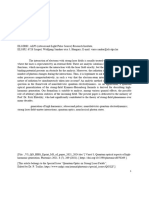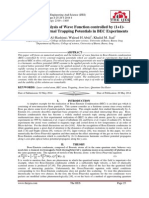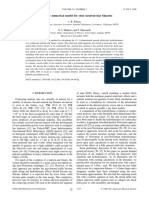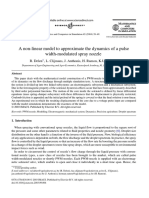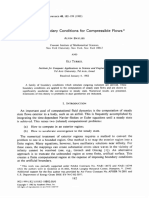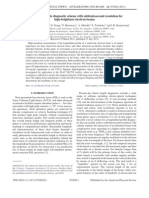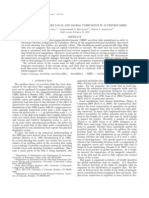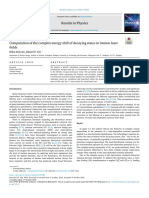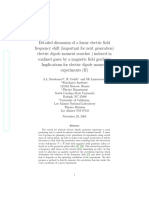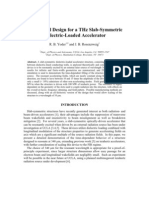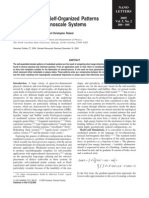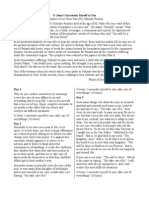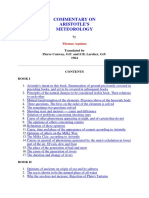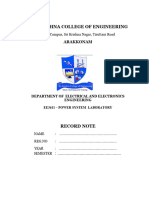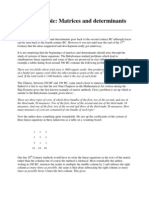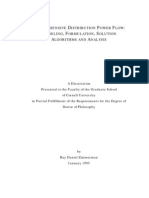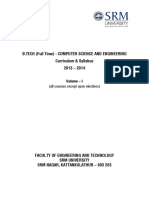Quantum Statistics of Overlapping Modes in Open Resonators: PACS Numbers: 42.50.ar, 42.55.ah, 42.60.da, 42.55.zz
Quantum Statistics of Overlapping Modes in Open Resonators: PACS Numbers: 42.50.ar, 42.55.ah, 42.60.da, 42.55.zz
Uploaded by
cdcrossroaderCopyright:
Available Formats
Quantum Statistics of Overlapping Modes in Open Resonators: PACS Numbers: 42.50.ar, 42.55.ah, 42.60.da, 42.55.zz
Quantum Statistics of Overlapping Modes in Open Resonators: PACS Numbers: 42.50.ar, 42.55.ah, 42.60.da, 42.55.zz
Uploaded by
cdcrossroaderOriginal Description:
Original Title
Copyright
Available Formats
Share this document
Did you find this document useful?
Is this content inappropriate?
Copyright:
Available Formats
Quantum Statistics of Overlapping Modes in Open Resonators: PACS Numbers: 42.50.ar, 42.55.ah, 42.60.da, 42.55.zz
Quantum Statistics of Overlapping Modes in Open Resonators: PACS Numbers: 42.50.ar, 42.55.ah, 42.60.da, 42.55.zz
Uploaded by
cdcrossroaderCopyright:
Available Formats
a
r
X
i
v
:
q
u
a
n
t
-
p
h
/
0
3
0
9
0
2
8
v
2
1
3
F
e
b
2
0
0
4
Quantum statistics of overlapping modes in open resonators
Gregor Hackenbroich, Carlos Viviescas, and Fritz Haake
Fachbereich Physik, Universitat Duisburg-Essen, 45117 Essen, Germany
(Dated: July 24, 2013)
We study the quantum dynamics of optical elds in weakly conning resonators with overlapping
modes. Employing a recently developed quantization scheme involving a discrete set of resonator
modes and continua of external modes we derive Langevin equations and a master equation for
the resonator modes. Langevin dynamics and the master equation are proved to be equivalent in
the Markovian limit. Our open-resonator dynamics may be used as a starting point for a quantum
theory of random lasers.
PACS numbers: 42.50.Ar, 42.55.Ah, 42.60.Da, 42.55.zz
I. INTRODUCTION
The interaction of a single resonator mode with an ex-
ternal optical eld leads to damping and noise for the
intracavity mode. The textbook example is a single os-
cillator linearly coupled to a continuum of harmonic os-
cillators [1, 2, 3, 4]. Less understood and in fact object of
ongoing debate [5, 6, 7, 8, 9, 10, 11, 12, 13] are the damp-
ing and noise properties of multimode elds in resonators.
Multimode elds show an excess noise or Petermann fac-
tor [5, 7, 14]. In laser systems this factor gives rise to
a peculiar enhancement of the laser linewidth above the
fundamental SchawlowTownes value; this enhancement
was measured in recent experiments on unstable laser
cavities [15, 16]. Excess noise and the enhancement of
the laser linewidth may be attributed to the nonorthogo-
nality and the spectral overlap of the cavity eigenmodes
[7] in the presence of the coupling to the external eld.
While the phenomenon of excess noise has been known
for more than 20 years, there is still no complete descrip-
tion of the quantum statistics of overlapping modes. A
few example systems were discussed [8, 9] from a quan-
tum mechanical point of view. Recently several authors
[10, 11, 12, 13] proposed quantum Langevin and mas-
ter equations for multimode elds; however, the status
of these equations remained unclear as they were not
derived from rigorously quantized electromagnetic elds.
This is in contrast to the quantum properties of a single-
mode eld (linearly coupled to an external heat bath)
which are known [1, 3, 4] for arbitrary damping strength
and arbitrary heat-bath temperature.
The goal of the present paper is to derive and clarify
the status of stochastic equations for the eld dynamics
in resonators with overlapping modes. The experimen-
tal motivation for our work derives both from realiza-
tions [15, 16] of unstable laser cavities and from recent
experiments of highly disordered dielectrics which form
mirrorless so-called random lasers [17, 18]. We address
the eld dynamics both within the Heisenberg picture
(in terms of quantum Langevin equations) and within
the Schrodinger picture (employing a master equation for
the reduced density matrix of the cavity modes). We go
beyond previous work in the following respects: (i) We
derive the eld dynamics starting from rigorously quan-
tized electromagnetic elds. In particular, no restriction
of the dimensionality and the vector character of the eld
strengths are indulged in. Keeping only resonant terms in
the eld Hamiltonian and adopting a Markov approxima-
tion for the memory of the bath (i.e., the electromag-
netic eld outside the resonator), we obtain the equations
of motion for the intracavity eld, including expressions
for all damping and noise forces. (ii) Our derivation clar-
ies the status of the resulting stochastic equations. In
particular, we show that they correctly describe sepa-
rated as well as spectrally overlapping resonances. Cor-
rections would only be important if the resonance widths
were to become comparable to the resonance frequencies
themselves, a regime not encountered in optical or even
microwave resonators. (iii) We derive a representation of
our master equation in terms of non-orthogonal modes
and compare our result with master equations proposed
earlier [10, 11, 13]. This allows us to specify the physical
conditions under which those previously proposed master
equations hold.
II. FIELD QUANTIZATION FOR
OPEN-RESONATOR GEOMETRIES
There is nothing to add to the familiar canonical quan-
tization of the electromagnetic eld [1, 2]. The eld com-
ponents may be expanded in terms of any complete set
of basis functions. As a matter of convenience one usu-
ally employs eigenmodes pertinent to the given geometry
and respecting the physical boundary conditions. Such
expansions are at issue here.
In the presence of a more or less open resonator, one of-
ten wants to distinguish between inside and outside
even though any opening, i.e., a hole in the material walls
of the resonator gives to the latter concepts an element of
arbitrariness. Any choice of a ctitious surface covering
the hole yields its own inside/outside separation. More-
over, dierent boundary conditions may be imposed at
the chosen separating surface. Nevertheless, each such
surface and boundary condition entail eigenmodes allow-
ing us to represent the electromagnetic eld almost ev-
erywhere, with the qualier almost reminding us of the
fact that the expansion cannot be expected to converge
2
pointwise everywhere, and in particular not on an arbi-
trarily chosen boundary.
The freedom in choosing the separating surface and
the boundary condition thereon may be used [19, 20, 21]
to dene a discrete set of inside modes which vanish out-
side; and similarly a continuum (or even several continua
distinguished by a channel index) of outside modes
which vanish inside and fulll scattering-type boundary
conditions at innity; a scattering condition species a
single channel for a wave coming in from innity and
entails dierent amplitudes for the partial waves going
out through the various channels. Canonical quantiza-
tion then amounts to representing the coecients of the
mode expansion of the electromagnetic eld by creation
and annihilation operators a
, a
of photons of the -
th inside mode and likewise b
m
(), b
m
() of photons of
the (m, )th outside mode, where m labels channels (in-
cluding polarization) and distinguishes modes within
the channel continuum. The bosonic commutators read
[a
, a
] =
,
, (1a)
[b
m
(), b
m
(
)] =
mm
(
) ; (1b)
moreover, inside operators commute with outside ones.
It was shown in two previous papers [20, 21] that the
Hamiltonian of the electromagnetic eld can be rigor-
ously expressed as the following bilinear form in the fore-
going creation and annihilation operators,
H =
m
_
d h b
m
()b
m
()
+ h
,m
_
d[J
m
()a
b
m
()
+1
m
()a
b
m
() + H.c.]. (2)
Here, the inside mode frequencies
as well as the inside-
outside coupling amplitudes J
m
, 1
m
reect the choices
made for the separating surface. The latter amplitudes
are integrals, taken over the separating surface, of prod-
ucts of inside (or outside) mode functions with deriva-
tives of outside (inside) mode functions. Specically, if
the vonNeumann boundary condition
n [u
I
= 0 (3)
was imposed for the inside modes u
and the Dirichlet
boundary condition
n v
m
()
I
= 0 (4)
for the outside modes v
m
() at the boundary I (with
normal vector n), the coupling amplitudes are given by
J
m
()=
c
2
2
_
I
d
2
r u
(r) n [v
m
(, r)],(5)
1
m
()=
c
2
2
_
I
d
2
r u
(r) n [v
m
(, r)].(6)
If the physical boundary conditions on material surfaces
entail time reversal invariance, the amplitudes J, 1 can
be chosen real and become identical, J = 1.
The derivation of the Hamiltonian takes full account of
three spatial dimensions as well as of the vector character
of the electric and magnetic elds E(x, t) and B(x, t); in
brief, the Heisenberg equations of motion generated by
that H are equivalent to the quantized Maxwell equa-
tions. Moreover, by composing the inside (outside) mode
functions with coecients a
, a
(b
m
(), b
m
()) one
gets the elds E(x, t) and B(x, t) inside (outside); trun-
cated such compositions will be robust against small
changes of the separating surface unless an unreasonable
choice was made to begin with.
Hamiltonians of the above form have been used [1, 6] in
quantum optics for high-quality resonators; there, inside
excitations are but slowly dissipated to the outside, with
life times long not only compared to typical internal pe-
riods 2/
but even to beat periods 2/, where
denotes the modulus of the typical frequency spacing of
neighboring internal modes. In such applications the an-
tiresonant terms 1
m
a
b
m
+1
m
a
m
can be neglected.
However, the derivation of Refs. [20, 21] also secures va-
lidity of Hamiltonian (2) for very much open resonators
where the outside eld causes the inside resonances to
overlap, the main case of interest in the present paper.
The Hamiltonian (2) even remains valid in the extreme
case of overdamped inside excitations, where mode fre-
quencies
are overwhelmed by large escape rates ; it
is only in that extreme situation, which appears as not
of interest in optics, that the antiresonant terms would
be important.
III. LANGEVIN EQUATIONS FOR
OVERLAPPING RESONANCES
While Hamiltonian (2) describes the coupled dynam-
ics of the inside and outside elds, its principle appli-
cation is to separate descriptions of those two subsys-
tems. As already indicated above, the continua of outside
modes tend to act as a bath damping the discrete in-
side modes. The eectively irreversible dynamics of the
inside modes becomes manifest when the bath degrees
of freedom are eliminated. The Heisenberg equations of
motion of the inside amplitudes a
, a
then take the
form of Langevin equations, in which the outside ampli-
tudes b
m
(), b
m
() enter only with their initial values
in inhomogeneities, the Langevin noise forces. Due to
the bilinear form of Hamiltonian (2) the Langevin equa-
tions can be determined rigorously by diagonalization of
H, i.e., without resorting to perturbation expansions (for
a single system oscillator the diagonalization was per-
formed in, e.g., Refs. [22] and [4]).
The Langevin equations to be noted in the present sec-
tion are simplied in three respects. First, we bar all an-
tiresonant terms, assuming the absence of overdamping.
Second, we conne the discussion to a Markovian situa-
3
tion valid for times larger than bath correlation times
bath
(like the thermal time
th
bath
= h/k
B
T); the exis-
tence of a time scale separation is thus assumed, such that
all inside lifetimes are much in excess of
bath
. Third, to
save space we do not bother to pedantically write out the
socalled frequency-shift terms which are rarely needed
in practice. The limit in question yields the Langevin
equations [21]
a
(t) =
(t)
(t) + F
(t) , (7)
wherein the damping matrix
and the noise force F
are given in terms of the inside-outside coupling ampli-
tudes J
m
as
=
_
JJ
, (8a)
F
(t) =
_
d e
(tt0)
m
J
m
b
m
(, t
0
) . (8b)
Note that the damping matrix is non-negative and
Hermitian; the neglected frequency-shift terms would
amount to an anti-Hermitian addition to . Under con-
ditions of time reversal invariance the matrix is even
real symmetric. The Markovian limit mentioned allows
us to drop the frequency dependence of the coupling am-
plitudes J over the spectral range in consideration and
to restrict the time span passed since the initial moment
t
0
as t t
0
bath
. In that limit the force has a white
spectrum according to F
(t)) = 0, and the noise
F
(t)F
(t
)) = 2
n
th
(t t
), (9a)
F
(t)F
(t
)) = 2
(1 + n
th
) (t t
) . (9b)
The second two-time correlation functions follows from
the rst and the commutation relations (1b). The re-
maining second moments vanish, F
(t)F
(t
)) = 0 =
F
(t)F
(t
)), and higher-order moments follow from the
ones of orders 1 and 2 according to Gaussian statistics.
The thermal number of photons n
th
= [exp( h /kT)
1]
1
appearing in the second moments must be taken as
frequency independent throughout the spectral range of
inside frequencies
under consideration. In the limit
kT h we recover the Langevin equations of Bardro
and Stenholm [10].
The appearance of a nondiagonal damping matrix
= JJ
signals that the Langevin equation may
legitimately be applied to the case of overlapping res-
onances, in which typical matrix elements
are larger
than a typical nearest-neighbor spacing of frequen-
cies. However, all elements of must be smaller in magni-
tude than the frequencies
themselves as antiresonant
terms were dropped in the derivation of Eq. (7). Con-
versely, we could specialize to the weak-coupling regime
[
[ . Then, lowest-order perturbation theory
simply amounts to dropping the o-diagonal elements of
the damping matrix,
0 for ,= , whereupon the
Langevin equation (7) simplies so as to describe a set
of mutually independent damped harmonic oscillators.
For some applications it will be helpful to rewrite the
above Langevin equation with the non-Hermitian matrix
H
= h
(10)
diagonalized. The eigenvalues of H will then represent
true resonances of the cavity. As a penalty for that
change of representation one would have to work with
non-standard commutation relations for the operators
connected with the eigenvectors of H (see Sec. VI).
A nal remark on the dynamics of the outside eld is
in order here. The time scale separation assumed in de-
riving the above Langevin equations is eective outside
as well as inside as the outside eld evolves in adiabatic
equilibrium with the inside eld for times t t
0
bath
.
For the quantitative treatment by the quantum optical
input-output formalism or, equivalently, scattering the-
ory we refer the interested reader to [1, 2, 21].
IV. MASTER EQUATION FOR OVERLAPPING
RESONANCES
We now come to the central section of the present pa-
per. Switching to the Schrodinger picture we present the
master equation for the reduced density operator (t) of
the inside eld equivalent to the Langevin equation of
the preceding section,
=
[a
, ] + (1 + n
th
)
_
[a
, a
]
+[a
, a
]
_
+ n
th
_
[a
, a
] + [a
, a
]
_
. (11)
This equation generalizes the familiar quantum optical
master equation for a single damped harmonic oscilla-
tor to many oscillators coupled by the (o-diagonal ele-
ments of the) damping matrix
. The latter coupling is
important when the damping is strong enough to cause
spectral overlap of modes. The rst double sum, pro-
portional to 1 + n
th
, describes spontaneous and induced
emission of photons towards the outside while the sec-
ond double sum, proportional only to n
th
, describes ab-
sorption from the outside; that interpretation is easily
checked by employing the Fock representation, i.e. the
representation in terms of eigenstates of the photon num-
ber operators a
.
Systematic and stochastic forces are not as clearly sep-
arated here as in the Langevin equation. In order to bring
about such distinction here as well, and to prepare for the
proof of equivalence of Eqs. (7) and (11) we may imagine
the density operator (t) at time t antinormally ordered
in the annihilation and creation operators (all as to the
left of all a
s); further, we rearrange the commutators
in the right-hand side of the master equation (11) such
4
that becomes antinormally ordered provided (t) is,
=
[a
, a
] [a
, a
]
+
[a
, a
] + [a
, a
]
+2n
th
[[a
, ], a
] . (12)
The latter form of the master equation preserves anti-
normal ordering of (t) at all times. Moreover, we have
now separated reversible drift terms (proportional to the
frequencies
), irreversible drift terms (
) not in-
volving the thermal number of quanta n
th
, and noise gen-
erated diusion terms ( n
th
); the latter interpretation
will become obvious in the following section where a rep-
resentation based on coherent states will be employed.
V. EQUIVALENCE OF LANGEVIN AND
MASTER EQUATIONS
There are various ways of demonstrating the equiva-
lence of the Langevin equations (7) and the master equa-
tion (11) and (12). A somewhat indirect (and, in fact, the
most laborious) way would be to start from the Liouville
von Neumann equation
inout
(t) = [H,
inout
(t)]/h
for the density operator of the full electromagnetic eld
and stick to the Schrodinger picture in eliminating the
outside eld, employing the same approximations as
in deriving the Langevin equations. A standard, and
more economical, procedure is to show that Eq. (7) and
(12) entail the same evolution equations for all mean
values
(a
)
m
(a
)
n
)(t) with integer exponents
m
, n
. We here prefer to employ a less familiar but
particularly elegant method.
If we consistently stick to antinormal ordering of (t)
we may write the commutators in the master equation
(12) as dierential operators as [a, ()] (/a
)() and
[(), a
] (/a)(). We may then just as well de-
grade all creation and annihilation operators to complex
c-number variables and the density operator to a real
function of those variables,
a
, a
, (t) P(,
, t) . (13)
The function P in question is the familiar Glauber
Sudarshan quasiprobability [1] which has as its moments
expectation values of normally ordered observables,
_
(a
)
m
(a
)
n
_
(t) = (14)
_
_
)
m
)
n
_
P(,
, t).
The master equation (12) then becomes the Fokker
Planck equation (with the shorthand /
,
/
P =
_
) (15)
+
+ 2n
th
_
_
P .
At this point the interpretation of the various terms in
the master equation (12) given earlier becomes obvious.
In the same vein we may degrade the Langevin equa-
tion to the c-number equation
(t) =
(t) +
(t), (16)
where
(t) is the c-number representative of the oper-
ator valued random force F
(t). Gaussian statistics and
zero mean are imparted to (t). Moreover, since observ-
ables are consistently to be taken as normally ordered we
must identify second moments as
(t)
(t
)) = F
(t)F
(t
)) = 2n
th
(t t
) ; (17)
while holding on to
(t)) = 0,
(t)
(t
)) = 0 and
Gaussian factorization for the higher-order moments.
At this point the equivalence proof can be carried out
by deducing the FokkerPlanck equation (15) from the
c-number Langevin equation (16), and to that task we
now turn. In order to make the argument as transpar-
ent as possible we drop mode indices; the initial time at
which statistical independence of the inside and outside
elds is assumed is taken as t
0
= 0. We start by con-
sidering a xed realization of the time-dependent ex-
ternal forces (t),
(t). The solution of the Langevin
equation is then a functional of the temporal course
taken by the external force between the initial and the
current time. Correspondingly, we introduce a density
W(,
, t[(t),
(t)) functionally depending on the
realization of the external eld under consideration; at
the initial time t = 0 the new density coincides with the
GlauberSudarshan P-function, W(0) = P(0). The den-
sity W obeys the evolution equation
W(t) =
_
L
0
+ l(t)
_
W(t) , (18)
L
0
= (
) + (
+ ) ,
l(t) =
_
(t) + (t)
_
.
Clearly, we encounter a rst-order partial dierential
equation since the random character of the external force
is not yet invoked. The time independent part L
0
of the
generator accounts for oscillation and damping, while l(t)
includes the time dependent forces (t),
(t). The for-
mal solution reads W(t) =
_
exp
_
t
0
ds(L
0
+ l(s))
_
+
W(0),
where ()
+
denotes positive time ordering. Temporarily
employing an interaction picture we split o the mo-
5
tion generated by L
0
as
W(t) = e
L0t
W(t) ,
W(t) =
_
exp
_
t
0
ds
l(s)
_
+
P(0) , (19)
l(t) = e
L0t
l(t)e
L0t
=
_
(t)
(t) + (t)
(t)
.
Now we may take the average over the Gaussian ensem-
ble of realizations of (t),
(t). The average of the -
dependent density W(t) is just the GlauberSudarshan
P-function, W(,
, t[(t),
(t))) = P(,
, t). In-
voking the above rst and second moments we get
P(t) =
_
_
exp
__
t
0
ds
l(s)
__
+
_
P(0)
=
_
exp
__
t
0
ds
_
t
0
ds
(s)(s
))
(s)
(s
)
__
+
P(0)
=
_
exp
_
2n
th
_
t
0
ds
(s)
(s)
__
+
P(0) . (20)
Upon dierentiating with respect to time we have
P(t) =
2n
th
(t)
(t)
P(t), and going back to P(t) = e
L0t
P(t),
we arrive at the FokkerPlanck equation (15) and have
thus arrived at our goal.
We should add that a mathematically more satisfac-
tory variant of the foregoing considerations would result
from employing the so-called Ito calculus [1].
VI. STATIONARY SOLUTION OF THE
MASTER EQUATION
The general time-dependent solution of the Fokker
Planck equation (12) is, due to the linearity of the drift
coecients and the constancy of the diusion matrix,
easy to construct [23]. We are in fact facing a stochastic
process of the OrnsteinUhlenbeck type. The Gaussian
distribution of the noise together with the linear evo-
lution equation (16) imply that the stochastic variables
must be Gaussian distributed. In particular, the station-
ary P function is immediately checked to be
P(,
) =
1
n
th
exp(
/n
th
). (21)
The dissipative coupling of the system modes is no longer
visible in the stationary state; rather, we encounter the
thermal equilibrium state one would also nd in the ab-
sence of spectral overlap.
VII. STATUS OF LANGEVIN AND MASTER
EQUATIONS AND RELATED LITERATURE
Multimode elds are more complex than single-mode
elds due the additional frequency scale set by the mean
frequency spacing of internal modes. For resonators
with overlapping modes the mode spectral broadening is
comparable to . Langevin or master equations may
then only be used if they provide a nonperturbative de-
scription of damping and noise (in the sense that the
mode decay rates may exceed the mode spacing ).
To show that the Langevin (7) and the master equa-
tions (11) and (12) are nonperturbative in the above
mentioned sense, we now drop the rotatingwave and
Markov approximation and address the exact eld dy-
namics. From the eld Hamiltonian (2) one obtains the
following set of Langevin equations
a
(t) =
(t)
_
t
t0
dt
(t t
)a
(t
)
+
(t t
)a
(t
+ f
(t). (22)
NonMarkovian eects and corrections to isolatedmode
behavior are encoded in the autocorrelation functions
(t t
) =
m
_
m
d
_
e
(tt
)
W
m
()W
m
()
e
+(tt
)
V
m
()V
m
()
_
, (23)
(t t
) =
m
_
m
d
_
e
(tt
)
W
m
()V
m
()
e
+(tt
)
V
m
()W
m
()
_
. (24)
The noise term takes the form
f
(t) =
m
_
m
d
_
e
i(tt0)
W
m
()b
m
(, t
0
)
+e
+(tt0)
V
m
()b
m
(, t
0
)
_
. (25)
Due to the bilinear form of the eld Hamiltonian the
exact Langevin equations are linear in the system and
bath operators. In principle, their solution can be found
by Laplace transformation. The details of the exact so-
lution will depend both on the spectral strength of the
bath and the frequency dependent coupling amplitudes
W
m
() and V
m
().
The result (22)(25) holds for arbitrary damping.
Here, our main focus is on quantum optical systems
where the oscillation frequencies much exceed the typ-
ical damping rates . Then our result can be used to
compute corrections to the Markovian dynamics of Secs.
IIIV. We substitute the ansatz a
(t) exp([ i]t)
with the damping rate into Eq. (22); here includes a
frequency shift . One obtains four terms proportional
to a
or a
, out of which three terms are strongly oscillat-
ing: the contribution V
W (WV
) has the oscillatory
integrand e
2 t
(e
+2 t
), respectively, and the term
V
W oscillates e
+2 t
with respect to a
(t). To
leading order in the ratio [[/ [ [/ only the
term WW
must be kept. The corrections of higher
order in [[/ are very small for the systems of interest
6
in quantum optics. We note that there are no correc-
tions of order [[/; thus our eld dynamics correctly
describes the regime of overlapping modes.
So far we described the eld dynamics in terms of
eigenmodes of a conveniently chosen closed system. The
associated mode operators a
, a
obey canonical com-
mutation relations. The master equation (11) may equiv-
alently be expressed in terms of a biorthogonal set of
modes representing the resonances of the open cavity. It
turns out that the operators associated with the reso-
nances obey nonstandard commutation rules. We focus
on the case kT h and write Eq. (11) in the form
=
h
(H
e
H
e
) + 2
, (26)
H
e
=
. (27)
The non-Hermitian matrix H was introduced in Eq. (10).
The complex eigenvalues of Hrepresent the resonances of
cavity in the presence of the coupling to the bath. Gen-
erally, the eigenvalues are nondegenerate, and H can be
diagonalized by a similarity transformation H = TT
1
.
The diagonal matrix comprises the eigenvalues of H
while T is a general matrix with complex entries. In
terms of two novel sets of operators
d
n
=
T
1
n
a
, (28)
e
n
=
T
n
, (29)
the eective Hamiltonian takes the diagonal form
H
e
=
n
e
n
d
n
. (30)
This result resembles the diagonal eld Hamiltonian of
closed resonators. However, the peculiar properties of
the open resonator dynamics are encoded in nonstandard
commutation relations of the new operators: From Eqs.
(28) and (29) and the canonical commutation rules for
the operators a
, a
one nds, e.g., [d
m
, e
n
] =
m,n
and [e
m
, e
n
] = A
mn
with A T
T. Substitution of Eq.
(28) into Eq. (26) yields the master equation
=
h
(H
e
H
e
) +
h
nm
A
nm
(
m
n
)d
m
d
n
.
This is the master equation proposed by Lamprecht and
Ritsch [13]. Our derivation provides a microscopic basis
for that equation [24] and proves the equivalence to the
master equation (11) in the limit kT h .
Acknowledgments
We thank H.J. Sommers and D. V. Savin for help-
ful discussions. This work has been supported by the
SFB/TR 12 der Deutschen Forschungsgemeinschaft.
[1] C. W. Gardiner and P. Zoller, Quantum Noise, 2nd edi-
tion (Springer, Berlin, 2000).
[2] D. F. Walls and G. J. Milburn, Quantum Optics (Sprin-
ger, Berlin, 1994).
[3] U. Weiss, Quantum Dissipative Systems, 2nd edition
(World Scientic, Singapore, 1999).
[4] F. Haake and R. Reibold, Phys. Rev. A 32, 2462 (1985).
[5] K. Petermann, IEEE J. Quantum Electron. 15, 566
(1979).
[6] S. M. Barnett and P. M. Radmore, Opt. Commun. 68,
364 (1988).
[7] A. E. Siegman, Phys. Rev. A 39, 1253 (1989); Phys. Rev.
A 39, 1264 (1989).
[8] Ph. Goldberg, P. W. Milonni, and B. Sundaram, Phys.
Rev. A 44, 1969 (1991).
[9] Ph. Grangier and J.Ph. Poizat, Eur. Phys. J. D 1, 97
(1998).
[10] P. J. Bardro and S. Stenholm, Phys. Rev. A 60, 2529
(1999); 61, 023806 (2000); 62, 023814 (2000).
[11] C. Lamprecht and H. Ritsch, Phys. Rev. Lett. 82, 3787
(1999).
[12] A. M. van der Lee, N. J. van Druten, M. P. van Exter, J.
P. Woerdman, J. P. Poizat, and P. Grangier, Phys. Rev.
Lett. 85, 4711 (2000).
[13] C. Lamprecht and H. Ritsch, Phys. Rev. A 65, 023803
(2002); 66, 053808 (2002).
[14] C. W. J. Beenakker, Phys. Rev. Lett. 81, 1829 (1998).
[15] Y.J. Cheng, C. G. Fanning, and A. E. Siegman, Phys.
Rev. Lett. 77, 627 (1996).
[16] M. A. van Eijkelenborg, A. M. Lindberg, M. S. Thijssen,
and J. P. Woerdman, Phys. Rev. A 55, 4556 (1997).
[17] S. V. Frolov, Z. V. Vardeny, and K. Yoshino, Phys. Rev.
B 57, 9141 (1998).
[18] H. Cao et al., Phys. Rev. Lett. 82, 2278 (1999); H. Cao
et al., Phys. Rev. Lett. 84, 5584 (2000); H. Cao et al.,
Phys. Rev. Lett. 86, 4524 (2001).
[19] D. V. Savin, V. V. Sokolov, and H.-J. Sommers, Phys.
Rev. E 67, 026215 (2003).
[20] G. Hackenbroich, C. Viviescas, and F. Haake, Phys. Rev.
Lett. 89, 083902 (2002).
[21] C. Viviescas and G. Hackenbroich, Phys. Rev. A 67,
013805 (2003).
[22] P. Ullersma, Physica (Utrecht), 32, 27 (1966); 32, 56
(1966); 32, 74 (1966); 32, 90 (1966).
[23] H. Risken, The FokkerPlanck Equation, 2nd edition
(Springer, Berlin, 1989).
[24] Our derivation shows that the master equation proposed
in Ref. [11] may describe the eld dynamics only in the
case of complete mode degeneracy.
You might also like
- The Man Who Got Even With GodDocument11 pagesThe Man Who Got Even With GodGoran Franjić100% (1)
- Paul Tillich - The New Being, Existential Sermons, 1955Document72 pagesPaul Tillich - The New Being, Existential Sermons, 1955mihneamoise100% (4)
- Quantizing Majorana Fermions in A Superconductor: C. Chamon, R. Jackiw, Y. Nishida, S.-Y. Pi, L. SantosDocument26 pagesQuantizing Majorana Fermions in A Superconductor: C. Chamon, R. Jackiw, Y. Nishida, S.-Y. Pi, L. SantospoecoekNo ratings yet
- Quantum Rotor Theory of Spinor Condensates in Tight TrapsDocument9 pagesQuantum Rotor Theory of Spinor Condensates in Tight TrapsgenhyinNo ratings yet
- 2407.04755v1Document36 pages2407.04755v1w2bcwhf2wqNo ratings yet
- Numerical Analysis of Wave Function Controlled by (1+1) - Dimensions External Trapping Potentials in BEC ExperimentsDocument5 pagesNumerical Analysis of Wave Function Controlled by (1+1) - Dimensions External Trapping Potentials in BEC ExperimentstheijesNo ratings yet
- RC Ieee Emc - RichalotDocument9 pagesRC Ieee Emc - RichalotPedro OliveiraNo ratings yet
- R. M. Avagyan, A. A. Saharian and A. H. Yeranyan - The Casimir Effect in The Fulling-Rindler VacuumDocument23 pagesR. M. Avagyan, A. A. Saharian and A. H. Yeranyan - The Casimir Effect in The Fulling-Rindler VacuumKorezmNo ratings yet
- For Exciton: Simple Calculating Energies Semiconductor Structures PDocument10 pagesFor Exciton: Simple Calculating Energies Semiconductor Structures PGusevNo ratings yet
- For The Numerical Simulation of Waves: Absorbing Boundary ConditionsDocument23 pagesFor The Numerical Simulation of Waves: Absorbing Boundary Conditionsleobruno210No ratings yet
- Srep 24742Document9 pagesSrep 24742Sanjana BhatiaNo ratings yet
- Electromagnetic Scattering Theory: Johns APL TechnicalDocument15 pagesElectromagnetic Scattering Theory: Johns APL TechnicalValerie LaneNo ratings yet
- Field Equations in Quantum ElectrodynamicsDocument35 pagesField Equations in Quantum Electrodynamicscifarha venantNo ratings yet
- Relativistic Numerical Model For Close Neutron-Star BinariesDocument15 pagesRelativistic Numerical Model For Close Neutron-Star BinariesJulian MonteroNo ratings yet
- Cold Atoms in Double-Well Optical Lattices V.I. Yukalov and E.P. YukalovaDocument24 pagesCold Atoms in Double-Well Optical Lattices V.I. Yukalov and E.P. YukalovaArturo CamachoNo ratings yet
- Mathematical PaperDocument11 pagesMathematical Paperkamran ashrafNo ratings yet
- Steffi E036614Document10 pagesSteffi E036614api-276885001No ratings yet
- 2013 - PRB. Quantum Cloaking Based On Scattering CancellationDocument6 pages2013 - PRB. Quantum Cloaking Based On Scattering CancellationDiego OliverNo ratings yet
- PhysRevE 82 056708Document13 pagesPhysRevE 82 056708alfr3No ratings yet
- Knöll, L., W. Vogel, and D-G. Welsch. "Resonators in Quantum Optics: A First-Principles Approach." Physical Review A 43.1 (1991) : 543.Document11 pagesKnöll, L., W. Vogel, and D-G. Welsch. "Resonators in Quantum Optics: A First-Principles Approach." Physical Review A 43.1 (1991) : 543.Lucas RibeiroNo ratings yet
- Wei - Paper For PetrophysicDocument13 pagesWei - Paper For Petrophysicyangwei00414312No ratings yet
- 1950 - Levine, Schwinger - On The Theory of Electromagnetic Wave Diffraction by An Aperture in An Infinite Plane Conducting Screen - Com PDFDocument37 pages1950 - Levine, Schwinger - On The Theory of Electromagnetic Wave Diffraction by An Aperture in An Infinite Plane Conducting Screen - Com PDFClaudio Biagini100% (1)
- 1996 Maxwell Bloch IDocument13 pages1996 Maxwell Bloch IAashutosh MistryNo ratings yet
- Semiconductor Nano RingsSemiconductorNanoringsDocument8 pagesSemiconductor Nano RingsSemiconductorNanoringsZsolt SzakácsNo ratings yet
- RingResonators TheoryandModelingDocument11 pagesRingResonators TheoryandModelingDaniel GrigoriNo ratings yet
- PPCF 372627 P 15Document16 pagesPPCF 372627 P 15Alexei VasilievNo ratings yet
- A Non-Linear Model To Approximate The Dynamics of A Pulse Width-Modulated Spray NozzleDocument10 pagesA Non-Linear Model To Approximate The Dynamics of A Pulse Width-Modulated Spray Nozzlerobert.cesarNo ratings yet
- 1712.05668... Entanglement Via PhononsDocument15 pages1712.05668... Entanglement Via PhononsMaryam BibiNo ratings yet
- Eikonal Waves, Caustics and Mode Conversion in Tokamak PlasmasDocument26 pagesEikonal Waves, Caustics and Mode Conversion in Tokamak PlasmasEstrella MedinaNo ratings yet
- Far Field Boundary Conditions For Compressible FlowsDocument18 pagesFar Field Boundary Conditions For Compressible FlowsmicNo ratings yet
- The Influence of Errors On Plasma-Confining Magnetic Fields - Kerst - 1962Document11 pagesThe Influence of Errors On Plasma-Confining Magnetic Fields - Kerst - 1962liubingxyNo ratings yet
- 108 MohanDocument10 pages108 MohanRECEP BAŞNo ratings yet
- The Original Hartree Paper From 1928Document22 pagesThe Original Hartree Paper From 1928Henrique CastroNo ratings yet
- Classification of Initial State Granularity Via 2d Fourier ExpansionDocument10 pagesClassification of Initial State Granularity Via 2d Fourier ExpansionFelicia YoungNo ratings yet
- Marty Pamir 1997Document17 pagesMarty Pamir 1997hassenebouhantNo ratings yet
- The Blume Emery Griffiths Model With Competing Interactions On The Bethe LatticeDocument11 pagesThe Blume Emery Griffiths Model With Competing Interactions On The Bethe Latticecesar abraham torrico chavezNo ratings yet
- Interference in A Two-Mode Bose System With N Particles Is TypicalDocument12 pagesInterference in A Two-Mode Bose System With N Particles Is TypicalcrocoaliNo ratings yet
- Self-Excited Current Oscillations in A Resonant Tunneling Diode Described by A Model Based On The Caldeira-Leggett HamiltonianDocument25 pagesSelf-Excited Current Oscillations in A Resonant Tunneling Diode Described by A Model Based On The Caldeira-Leggett HamiltonianAzhar MahmoodNo ratings yet
- Dynamics of Magnetic VorticesDocument38 pagesDynamics of Magnetic Vorticespiyushsinha64817No ratings yet
- Longitudinal Profile Diagnostic Scheme With Subfemtosecond Resolution For High-Brightness Electron BeamsDocument8 pagesLongitudinal Profile Diagnostic Scheme With Subfemtosecond Resolution For High-Brightness Electron BeamsParticle Beam Physics LabNo ratings yet
- Vftos in GISDocument5 pagesVftos in GISdeepak_27No ratings yet
- Dynamical Superfluid-Insulator Transition in A Chain of Weakly Coupled Bose-Einstein CondensatesDocument5 pagesDynamical Superfluid-Insulator Transition in A Chain of Weakly Coupled Bose-Einstein CondensatescdcrossroaderNo ratings yet
- Longitudinal Dispersion of Orbital Angular Momentum Modes in High-Gain Free-Electron LasersDocument8 pagesLongitudinal Dispersion of Orbital Angular Momentum Modes in High-Gain Free-Electron LasersParticle Beam Physics LabNo ratings yet
- Correlated Emission Laser, Quenching of Spontaneous Noise and Coupled Pendulum AnalogyDocument5 pagesCorrelated Emission Laser, Quenching of Spontaneous Noise and Coupled Pendulum AnalogyresearchinventyNo ratings yet
- H. Lim Et Al - Subgrid Models in Turbulent MixingDocument5 pagesH. Lim Et Al - Subgrid Models in Turbulent MixingMfdrrNo ratings yet
- Models - Woptics.mach Zehnder ModulatorDocument58 pagesModels - Woptics.mach Zehnder ModulatorLeão AmaruNo ratings yet
- Split Ring ResonatorDocument5 pagesSplit Ring ResonatorRicha SharmaNo ratings yet
- Kareem A. Sorathia, Christopher S. Reynolds, Philip J. ArmitageDocument8 pagesKareem A. Sorathia, Christopher S. Reynolds, Philip J. ArmitageksoratNo ratings yet
- Computation of The Complex Energy Shift of Decaying States - 2023 - Results in PDocument4 pagesComputation of The Complex Energy Shift of Decaying States - 2023 - Results in Pronaldquezada038No ratings yet
- Angular-Asymmetric Transmitting Metasurface and Splitter For Acoustic Wave: A Combining of The Coherent Perfect Absorber and LaserDocument14 pagesAngular-Asymmetric Transmitting Metasurface and Splitter For Acoustic Wave: A Combining of The Coherent Perfect Absorber and LaserCarlos FazNo ratings yet
- Daniel Neuhauser and Roi Baer - A Two-Grid Time-Dependent Formalism For The Maxwell EquationDocument10 pagesDaniel Neuhauser and Roi Baer - A Two-Grid Time-Dependent Formalism For The Maxwell EquationPrem_SwiftNo ratings yet
- Cuernavaca 05Document91 pagesCuernavaca 05Everton ArtusoNo ratings yet
- Maxwell Equations and Physical Interpretation of Each of Them in Differential and Integral FormsDocument23 pagesMaxwell Equations and Physical Interpretation of Each of Them in Differential and Integral FormsClara VelezNo ratings yet
- Electric Dipole Moment Searches Effect oDocument31 pagesElectric Dipole Moment Searches Effect odeniseedube01No ratings yet
- Yoder 2004 645Document7 pagesYoder 2004 645Particle Beam Physics LabNo ratings yet
- Analysis of Finite Phased Arrays of Printed DipolesDocument9 pagesAnalysis of Finite Phased Arrays of Printed Dipolesadrian.raba500.anrbNo ratings yet
- Self Consistent Automatic QFT Predictions of Particle Masses (24 July 2014 Revision)Document16 pagesSelf Consistent Automatic QFT Predictions of Particle Masses (24 July 2014 Revision)Nige CookNo ratings yet
- Fenvik, მარტი 2012Document7 pagesFenvik, მარტი 2012emediageNo ratings yet
- Syllabus QM Old CBCSDocument5 pagesSyllabus QM Old CBCSChitsimran Singh AroraNo ratings yet
- M. Takahashi Et Al - Effective Field Theory For Spinor Dipolar Bose Einstein CondensatesDocument11 pagesM. Takahashi Et Al - Effective Field Theory For Spinor Dipolar Bose Einstein CondensatesPomac232No ratings yet
- PhysRevB 89 125413Document10 pagesPhysRevB 89 125413Saurabh BasuNo ratings yet
- On The Joint Probability of Correlated Physical OccurrencesDocument9 pagesOn The Joint Probability of Correlated Physical OccurrencescdcrossroaderNo ratings yet
- (Thomas Aquinas, Brian Davies, Richard Regan) On E PDFDocument559 pages(Thomas Aquinas, Brian Davies, Richard Regan) On E PDFcdcrossroaderNo ratings yet
- N Assica. Quantum: Ana. C. ZaniesDocument5 pagesN Assica. Quantum: Ana. C. ZaniescdcrossroaderNo ratings yet
- Time Symmetry and Interpretation of Quantum Mechanics: O. Costa de Beauregard 1Document21 pagesTime Symmetry and Interpretation of Quantum Mechanics: O. Costa de Beauregard 1cdcrossroaderNo ratings yet
- Mother Mary PotterDocument18 pagesMother Mary PottercdcrossroaderNo ratings yet
- Lindblad Equation and Its Semi-Classical Limit of The Anderson-Holstein ModelDocument30 pagesLindblad Equation and Its Semi-Classical Limit of The Anderson-Holstein ModelcdcrossroaderNo ratings yet
- Novena of Surrender To The Will of GodDocument2 pagesNovena of Surrender To The Will of Godrichnj100% (2)
- Commentary On MeteorolgyDocument94 pagesCommentary On MeteorolgycdcrossroaderNo ratings yet
- Time Symmetry and Asymmetry in Quantum Mechanics and Quantum CosmologyDocument32 pagesTime Symmetry and Asymmetry in Quantum Mechanics and Quantum CosmologycdcrossroaderNo ratings yet
- Hassing Aquinas On Phys Vii 1Document49 pagesHassing Aquinas On Phys Vii 1cdcrossroaderNo ratings yet
- Farrar Life of ChristDocument578 pagesFarrar Life of ChristcdcrossroaderNo ratings yet
- Aristotle's Metaphysics Reconsidered: Has Stimulated Intense Renewed Debate in The Past TwentyDocument29 pagesAristotle's Metaphysics Reconsidered: Has Stimulated Intense Renewed Debate in The Past TwentycdcrossroaderNo ratings yet
- Eele461 Module 07Document48 pagesEele461 Module 07cdcrossroaderNo ratings yet
- Origin of Quantum Noise and Decoherence in Distributed AmplifiersDocument11 pagesOrigin of Quantum Noise and Decoherence in Distributed AmplifierscdcrossroaderNo ratings yet
- Putnam Looks at Quantum Mechanics (Again and Again)Document27 pagesPutnam Looks at Quantum Mechanics (Again and Again)cdcrossroaderNo ratings yet
- Linear Algebra .Ageometric Approach W.H.freemanDocument17 pagesLinear Algebra .Ageometric Approach W.H.freemanMatias GomezNo ratings yet
- 2 Matrix OrganizationsDocument3 pages2 Matrix OrganizationshelperforeuNo ratings yet
- PSS Lab Manual 2023Document82 pagesPSS Lab Manual 2023k vasanthiNo ratings yet
- 10 1108 - HFF 06 2022 0368Document18 pages10 1108 - HFF 06 2022 0368yangdw1998No ratings yet
- Solution-7Document30 pagesSolution-7veertambi29No ratings yet
- 02 - Bharghav Fake News DetectionDocument49 pages02 - Bharghav Fake News DetectionDileep Kumar UllamparthiNo ratings yet
- FEM For Heat Transfer Problems (Finite Element Method) Part 3Document16 pagesFEM For Heat Transfer Problems (Finite Element Method) Part 3Sibilla UnniNo ratings yet
- Complete PSLPDocument17 pagesComplete PSLPuday bariNo ratings yet
- 1 Academic-1Document73 pages1 Academic-1usman arifNo ratings yet
- Matrices and Determinants PDFDocument7 pagesMatrices and Determinants PDFARANGWALANo ratings yet
- Introduction To CFD Basics Rajesh BhaskaranDocument17 pagesIntroduction To CFD Basics Rajesh BhaskaranSuta VijayaNo ratings yet
- Csc461: Lecture 16 Opengl TransformationsDocument20 pagesCsc461: Lecture 16 Opengl Transformationsrahul.yerrawarNo ratings yet
- UNIT 1 - 2023-24 Part 1Document15 pagesUNIT 1 - 2023-24 Part 1Bhagyalaxmi TambadNo ratings yet
- Preliminaries: in Fortran 77, Numerical Recipes in Fortran 90, and Numerical Recipes in C AreDocument19 pagesPreliminaries: in Fortran 77, Numerical Recipes in Fortran 90, and Numerical Recipes in C AreGuilherme E Tamira LopezNo ratings yet
- Capitulo 9 ControlDocument20 pagesCapitulo 9 ControlRaul Roque YujraNo ratings yet
- SNU Computer ScienceDocument35 pagesSNU Computer ScienceSayan BanerjeeNo ratings yet
- PHD ThesisDocument197 pagesPHD ThesisNormiza Mohd NoorNo ratings yet
- Mabruk Conf Adaptive ICC 2009Document6 pagesMabruk Conf Adaptive ICC 2009mgheryaniNo ratings yet
- 11th Mathematics em Reduced Syllabus GuideDocument24 pages11th Mathematics em Reduced Syllabus GuideSuruli GaneshNo ratings yet
- Determinants, Part III Math 130 Linear Algebra: TH THDocument4 pagesDeterminants, Part III Math 130 Linear Algebra: TH THCody SageNo ratings yet
- State Testing, and Testability Tips. Power of A Matrix, Node Reduction AlgorithmDocument13 pagesState Testing, and Testability Tips. Power of A Matrix, Node Reduction AlgorithmSeerapu RameshNo ratings yet
- Pde ParabolicDocument49 pagesPde Parabolicashraf shalghoumNo ratings yet
- Simbol Matematik 2Document12 pagesSimbol Matematik 2Anonymous Ztyzc5No ratings yet
- Fundamentals of Datastructures and Algorithms (ICT 4303)Document3 pagesFundamentals of Datastructures and Algorithms (ICT 4303)DuoDrenchNo ratings yet
- AlgebraDocument26 pagesAlgebratuaNo ratings yet
- Btech Syll Cse r2013-14Document245 pagesBtech Syll Cse r2013-14rishikarthickNo ratings yet
- Voltage Stability Assessment Using Equivalent Nodal AnalysisDocument10 pagesVoltage Stability Assessment Using Equivalent Nodal AnalysisZaf FeerNo ratings yet
- Rigid Motions and Homogeneous Transformations: 2.1 Representing PositionsDocument12 pagesRigid Motions and Homogeneous Transformations: 2.1 Representing PositionsMuhammad UsmanNo ratings yet
- SchedulesDocument43 pagesScheduleslalomg_straussNo ratings yet




